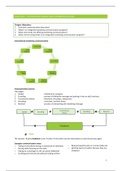CHAPTER 1 INTEGRATE D MARKETING COMMUNICATIONS
Chapter Objectives:
1. How does communication take place?
2. What is an integrated marketing communications program?
3. What new trends are affecting marketing communications?
4. What are the components of an integrated marketing communication program?
International marketing communication
Advertising
Public Digital
Relations Marketing
Sales
Social Media
Promotions
Personal Alternative
Selling Marketing
Direct Database
Response Marketing
Communication process
Five stages:
1. Sender - Individual or company
2. Encoding - process of taking the message and putting it into an add, brochure..
3. Transmission device - television, the paper, salesperson
4. Decoding - consumer, business buyer
5. Receiver - process of interpreting the marketing message
Transmission Decoding Receiver
Sender Encoding
Device
Feedback
= Noise
The receiver → gives feedback to the → seller → the seller use this information to start the process again.
Examples communication noise:
o Taking on the phone during a commercial on television o Being annoyed by ads on a social media site
o Driving while listening on the radio o Ignoring tweet on twitter because they are
o Talking to a passenger as the car passes billboards irrelevant
o Scrolling past internet ads without looking at them
1
,Chick-fil-A Social Media
o Integrates online with offline o Allows fans to interact
o Facebook – 500 profile mentions o Announces specials, provides coupons
o Official Chick-fil-A Facebook page o Promotions on Twitter
o Fans helps administer the page o “Eat Mor Chikin” offline advertising
Integrated marketing communication: is the coordination an integration of all marketing
communication tools, avenues, and sources within a company into seamless program which maximizes
the impact on consumers and other end-users at a minimal cost.
Steps of a marketing plan
o Current situation analysis
o SWOT analysis
o Marketing objectives
▪ Target market
o Marketing strategies
o Marketing tactics
o Implementation
o Evaluation and performance
Marketing communication plan
o Analysis of the situation
o Marketing communication target groups (personas) 20-30 years old, companies similar
o Marketing communication goals
o Marketing communication strategy ( positioning/proposition = message = promise)
o Marketing communication tools / channels / platforms
o Planning
o Cost analysis (personal costs (energy money), costs of advertising on Facebook, Instagram)
o Evaluation
o Literature / sources
Trends affecting marketing communications
o Emphasis on accountability & measurable results
o Explosion of the digital arena
o Integration of media platforms
o Shift in channel power
o Increase in global competition
o Increase in brand parity
o Emphasis on customer engagement
Explosion of Digital Media
o Emerge of
▪ Interactive Web sites, blogs, and social networks
▪ Smartphones, tablets, other devices
o Companies shifting expenditures from traditional to digital media
o Social media allows interaction
Integration of Media platforms
o Consumers integrate platforms
▪ 5 hours 16 minutes – non-television screens
▪ 4 hours 31 minutes – television
o Way consumer integrate media formats
▪ Content grazing (2 or more screens simultaneously)
▪ Investigative spider-webbing (multiple platforms)
▪ Quantum journey (PC, smartphone, app, etc)
▪ Social spider-webbing (share content multiple devices)
2
,Changes in Channel Power
o Retailers
▪ Control channel
▪ Control shelf space
▪ Have purchase data
▪ Determine products and brand on shelves
o Consumers
▪ Internet shifts power to consumer
▪ Multiple methods of making purchases
Emphasis on Customer Engagement
o Marketers seek to engage customers
o Contact points important
o Digital media now part of IMC
o Two-way communication
o Strive to develop emotional commitment
International Implications
o Goal → to coordinate marketing efforts
o Greater challenge due to national and cultural differences
o Standardization versus adaption
o Think globally, but act locally
3
, Marketing communication plan:
Consumer Buying Hierarchy of Goals Message : means- Goals of your
attitude behaviour effects end theory message
Cognitive Need Awareness 80-70 % are Attribute - Benefit To inform
Information Knowledge aware, have – Personal Value To trigger need
search knowledge Rational or Create brand
emotional awareness
Affective Evaluating Liking 50% like or Personal value To like
the Preference prefer the Rational or Trigger emotion
alternatives product emotional
Conative Purchase Conviction 10% will buy or Persuasion – take To persuade
Post Purchase engage action To take action
purchase 5% will be very Rational or To buy
happy emotional
→ triggering the needs, do you know what will happen in 2 years, do you update yourself?
The consumer attitude is connected to the buying behaviour. (start of journey map)
Advertising design Appeal Source Traditional Traditional
channel (offline) channel (online)
Generic, preemptive, unique Expert Newspaper
selling proposition, hyperbole, ? Typical persons Magazine
comparative
Resonance, emotions ? Celebrities Radio
CEOs
Encourage customer action, Source TV, out of home
support promotional efforts, ?
impulse buys
4





